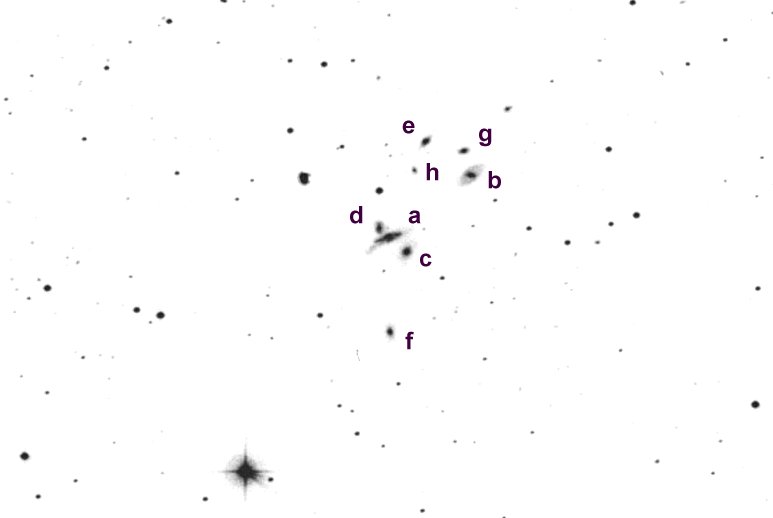

| HICKSON | NAME | SIZE (M) | MAG (V) | SB |
| 57a | 1.7X0.5 | 13.6 | 13.2 | |
| 57b | 1.1X0.5 | 14.2 | 13.5 | |
| 57c | 0.8X0.7 | 13.9 | 13.1 | |
| 57d | 0.4X0.3 | 14.3 | 12.0 | |
| 57e | 0.7X0.4 | 14.8 | 13.2 | |
| 57f | 0.8X0.5 | 13.9 | 12.7 | |
| 57g | 0.4X0.2 | 15.2 | 12.4 |
Hickson 57 in Leo is better known as "Copeland's Septet" and was discovered on February 9, 1874 by Ralph Copeland, an assistant on Lord Rosse's 72-inch. This challenging group consists
of 7 NGC galaxies (3745, 3746, 3748, 3750, 3751, 3753, 3754) contained within a 5' circle and requires a 10"-12.5" scope for a decent view. Unfortunately, Copeland confused the field with a
nearby area containing two faint galaxies (
NGC 3753 is the brightest member of Hickson #57 at 13.6V. In my 17.5-inch I logged it as "faint, fairly small, elongated 5:2 WNW-ESE, containing a bright core." NGC 3750 is a faint companion (13.9V) just 0.7' southwest that simply appears as a very small, round knot. Even dimmer is NGC 3754 situated just off the northeast end of NGC 3753. A second close trio is located about 3' northwest. The brightest of these three, NGC 3746, glows dimly at 14.2V and although photographs reveal a barred spiral, I only noted a very small, round, featureless spot. Two faint glimmers, NGC 3745 and NGC 3748, were barely visible 1' north and 2' northeast, respectively. Finally, less than 3' south of NGC 3753 is NGC 3751, comparable in difficulty to the two companions of NGC 3746.
While examining the field of Copeland's Septet with my 17.5-inch I was surprised to pick up an 8th galaxy-
